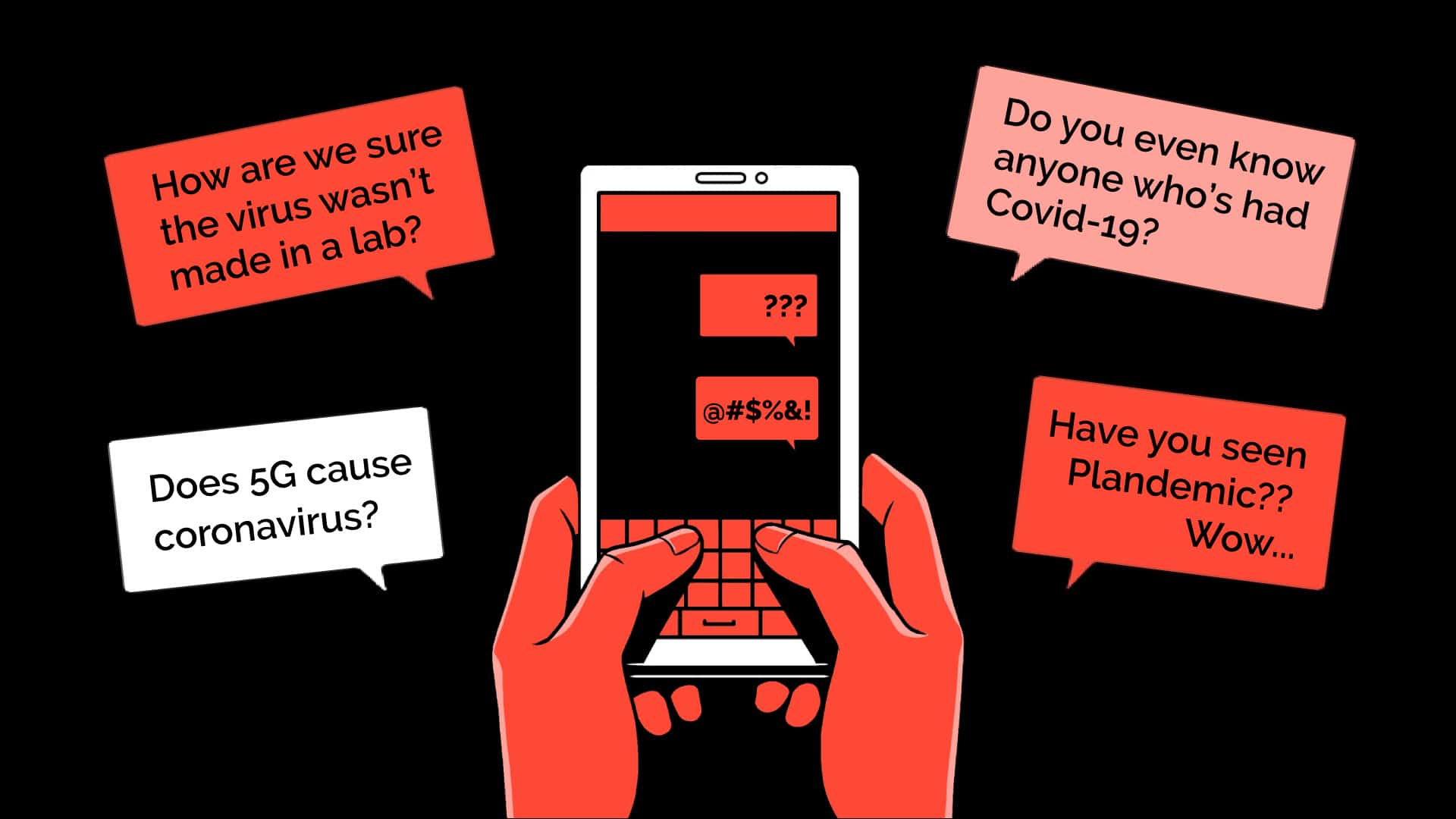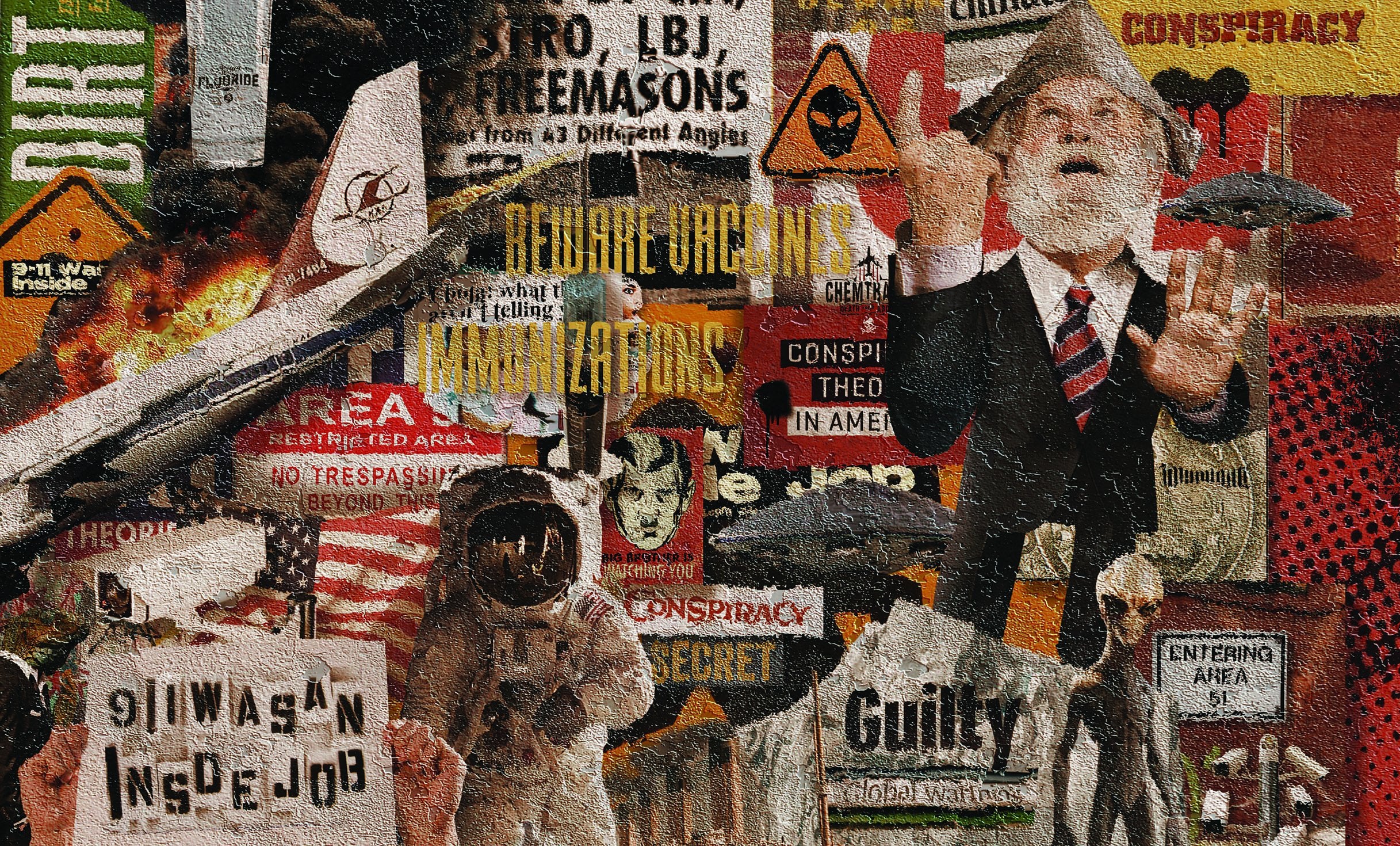By Alex Newe
The paranoid mind is a place of trepidation. The feeling that everything around you is moving too fast and too out of reach. You are left to grasp at any sense of thought whether it be factual or fictitious. This place has become a place of comfort for many people in today’s time. 21st century politics are brazen with a paranoid style and with the aftermath of the 2016 election, we now live in a political landscape of conspiratorial thinking and a post-truth society. But what brought us to this direct point in time? With the onslaught of modern conspiracies such as the 5G tower epidemic, it is important to note that these are simply reiterations of a way of thinking that has been with us for generations. Through the writings of Richard Hofstadter as well as a number of other writers, we will explore the underlying fear of progress as well as globalization as part of the root causes of conspiracy. And with the birth of the digital age, Emma Grey Ellis’s article will highlight how conspiratorial thinking has wreaked havoc on media, specifically news reporting and journalistic integrity. While there are a number of theories to expand these ideas on, we will explore them through the lens of the 5G tower conspiracies concerning the coronavirus outbreak.
When examining conspiracy, one needs to look at the thought process behind a conspiratorial mindset. More often than not, ridiculously absurd conspiracy theories provide a structured narrative that explains something that would otherwise be too complex to comprehend. In other words, conspiracy theories work better in today’s society because it complies with a particular thought process. In Richard Hofstadter’s article, he explains how the media’s portrayal of paranoid ideologies reinforce a way of thinking that involves “heated exaggeration” and suspiciousness of one’s daily life. People in a conspiratorial mindset often feel threatened, like something is being taken away from them such as their rights. They become determined to find an answer to the problem at hand. They see themselves as a savior for humanity, and as a “militant leader” (Hofstadter 1). For instance, the 5G conspiracy theorist believes that the government created 5G towers to spread the novel coronavirus. These individuals are frightened for their health and safety and will do anything to prevent others from this supposed “crisis”, going as far as burning down 5G towers across the globe. Through Hofstadter’s explanation, the reason why people are convinced that the towers are causing a myriad of problems, stems down to general suspiciousness with technology and globalization. We have a harder time fully understanding how a complex technological product like the 5G network actually functions, so in order to maintain sanity we grasp onto conspiratorial thinking.
The prime breeding ground for a conspiracy to flourish is a banal surface. Like the words of prophets on subway walls, conspiracy theorists search for clandestine agencies hidden in the most obvious places (Stewart 88). The cell phone towers are a prime example of this. They are all over the world and because they have become accepted by society, they have become somewhat invisible. The 5G towers are a perfect vessel to push conspiratorial narratives into for two reasons. The first being that it is a banal surface as we have accepted the technology of cell phone towers into daily life. And the second being that while we have accepted it, most of us have no understanding of how cell phone towers work. This is important because one of the key facets of turning to conspiratorial thinking is lack of understanding.
This idea of discomfort and not being able to comprehend something can be further elaborated through the words of Ellis. Technology is an area that grows incredibly fast, and this has its drawbacks. The main one being society’s understanding. With the growth of technology comes the gap of understanding in how it works. Pair this with the birth of the Internet and you have a perfect place for conspiratorial thinking to prosper and grow. 5G was not a popular subject matter until late 2019. However, because of the coincidental coronavirus outbreak and subjective quarantine, people were at home, and, quite literally left to their own devices. Access to social sites like Twitter and Facebook provided a platform with the potential to connect like-minded individuals with similar paranoid theories to feed off of one another. Another sinister facet of the internet is photoshop. Ellis goes in depth with how easily photos and videos can be manipulated by anybody with a mobile device. Photoshop by today’s standards has gotten incredibly sophisticated with the advent of AI technology that reads faces and bodies. What is especially concerning is something by the name of Poe’s Law. This law concerns internet meme culture, and how jokes and GIFs that are usually innocently satirical can easily morph into a full-fledged conspiracy theory with a cult following (Ellis). Twitter users as well as other platform users were able to photoshop fake charts highlighting how coronavirus was caused by 5G radio waves infecting the body. While this was later debunked by scientists and pathologists, the resulting damage was well ingrained in the public domain. Social media platforms as well as entertainment sites like YouTube offer a perfect place for individuals to share and build off of conspiracies.
While media sites offer a place to share conspiracies, film and television reinforce these concepts and ideas through their subject matter. Pop culture is ridden with secret government organizations, as well as mysterious unknown forces out to cause chaos (Stewart 89). The Parallax View, The Manchurian Candidate, and even more modern media such as Black Mirror offer up themes regarding disillusionment and paranoia. Hollywood does extremely well with conspiratorial themes in movies and television as they are popular among society. Even looking at kids cartoon shows like SpongeBob, conspiratorial themes are present. In a specific episode, the villain, Plankton, utilizes radio towers to control the minds of Bikini Bottom residents. As a kid watching this, I thought it was hilarious, but a decade later and I’m making the connections. It is eerily reminiscent of the paranoia regarding the 5G tower conspiracy theory. The 5G theory itself is a reiteration of the general paranoia of radio towers and cell phone towers. Pretty much anything regarding the electromagnetic spectrum can be traced to mind control or sickness conspiracy theories.
Media and conspiratorial thinking go together like bread and butter. We look to the media for guidance and for awareness, and with today’s collapse of transparent journalism, conspiracy is thriving. Where we once used to have a seemingly high standard of trust in journalistic integrity has gone out the window for the post-Trump era of fake news and paranoid politics (Francis 51). When political figure like Donald Trump deliberately undermine news organizations like the New York Times, or The Washington Post, people turn to ulterior sources of information. This is why we see cult personalities like Alex Jones growing in popularity. People look to him to give some semblance of an answer to the chaos that is the socio-political atmosphere. Facts and truth don’t stand a chance when emotions are put on the line. Alex Jones has repeatedly reinforced the idea that 5G waves will harm you and your children. So, putting ourselves in the mindset of a desperate individual that feels as though they cannot trust typical news organizations explaining that 5G is in fact harmless. To them, their health and safety is on the line however, and this triggers an emotional response. People get angry and defensive. This is where we see the burning of hundreds of 5G towers in the UK. As long as pseudo-saviors that have platforms can continue to spread misleading information, we will continue to live in the golden age of conspiracy theories (Garber).
Conspiracy theories give an answer to a question that is often too complex to understand. The paranoia regarding 5G stems back to radiophobia, as said previously. Since we were able to harness the power of the electromagnetic spectrum, there has been a global concern with the health and safety of people. It was a fear of radios in the early 20th century, and then microwave ovens in the 1970’s. And now it is concern over high speed 5G cell phone networks. With globalization and the improvements in technology, we live in a world that moves at breakneck speed. Information overload is a symptom of living in this time period and feeling as though you can’t keep up with society can be overwhelming as well as disorienting. Because there is a gap of understanding with complex technologies like the 5G networks, this gap needs to be filled by something. It makes humans very uncomfortable to be in the unknown for too long, so there is always a demand for an answer. Yet, with subject matter like 5G and the electromagnetic spectrum, it is often quite dense. With complex technologies comes complex problem solving ot get there. So, rather than try to comprehend something complex like the electromagnetic spectrum, it is easier to attach a ludicrous and inventive conspiracy theory. It is all rooted in insecurity with a lack of understanding. It is much easier to say that the box full of complex tech is secretly trying to give your coronavirus or control your brain than to actually understand the technology inside. It is also worth noting that many people feel as though their privacy is being infiltrated. With the development of new technologies comes the push to be more integrated in society. Specifically, with 5G, there is a need for more cell towers because the frequency waves are smaller. So, there will be more 5G boxes installed in neighborhoods and on houses. This inherently causes suspicion and discomfort.
Taking a look at the group dynamic that believes in the 5G conspiracy theories, you can start to see a pattern forming. Many of Alex Jones supporters, Trump supporters, as well as older conservatives make up the majority of American believers in the 5G conspiracy. This is partly because Trump instilled paranoia and suspicion in the early days of coronavirus. And partly because Alex Jones supporters lean right. But one of the most important factors is age. Many 5G conspiracy theorists are older people that grew up without things like the internet or high-speed networks, so 5G is still very new and uncomfortable for them. The problem with all of this, though, is that the concurrent paranoia stunts the development of society. When Donald Trump tweets that covid-19 is a hoax, and Alex Jones talks about 5G being harmful, thousands of eyes and ears are absorbing this information. It reinforces the idea that we should not progress technologically. It spreads suspicion and growing distrust in our science and technology, which is incredibly damaging to progress. As journalist Megan Garber explains, the ramifications will result in a country that thinks “there are more important things than the truth” (Garber 1).
We are entering the golden age of conspiracy theories and paranoid politics. A time where the truth is less important than appearance and emotion. The irony of it all is that we are more connected as a world than we ever have been in the history of the human race. However, we are also extremely divided through algorithms and bias. Globalization has mobilized the world, and we are struggling to catch up with its speed. So, conspiratorial thinking offers a pacifier of sorts, soothing our discomfort for a false sense of security. If we are to live in a world where technology surpasses the capability of understanding, we have to discuss this as a society. We can no longer ignore science and proper journalism in favor of cult personalities and celebrities. If we are going to pull ourselves out of this enigma, we are going to have to confront the truth.
Works Cited
Ellis, Emma Grey. “The WIRED Guide to Online Conspiracy Theories.” Wired, Conde Nast, 10 May 2018, www.wired.com/story/qanon-supporters-arent-quite-who-you-think-they-are/.
Francis, Marc. “Editor’s Introduction: Documenting Conspiracy and Conning in the Age of Misinformation.” Film Quarterly (2020), vol. 74, no. 1, 2020, pp. 51–74., doi:https://doi.org/10.1525/fq.2020.74.1.51.
Garber, Megan. “The Lasting Trauma of Alex Jones’s Lies.” The Atlantic, Atlantic Media Company, 4 Aug. 2018, http://www.theatlantic.com/entertainment/archive/2018/08/the-lasting-trauma-of-alex-joness-lies/566573/.
Hofstadter, Richard. “The Paranoid Style in American Politics.” Harper’s Magazine, Nov. 1964.
Stewart, Kathleen. Ordinary Affects. Duke University Press, 2007.







One Comment Add yours